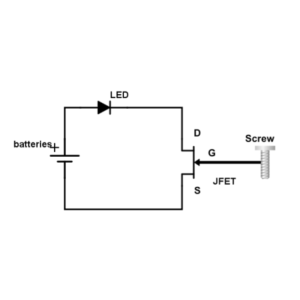Get Your Science On: StaticSaurus
This week, Heather shows us how to build a toy that detects static electricity!
How It Works:
A FET is a type of transistor. It works in way analogous to a water tap on a garden hose. The relatively large current through the LED bulb can be switched on and off by a small electric field field in the transistor. When something has a static electric charge and is brought near the screw, it creates an electric field in the screw, which is connected to the gate of the transistor, which turns on an electric current and makes the LED light up.
Materials:
- batteries (we used two AA) and a holder
- LED lights bulbs
- a transistor per LED light (we used a 2N5459 N-Channel J-FETs)
- wires and a way to attach them (breadboard or solder)
- metal screws
How To Build:
A FET (transistor) has 3 connections: Gate (G), Source (S), and Drain (D), which for our particular transistor go in that order from left to right as you look at the curved side.
See the circuit schematic below. Take your batteries and connect them in series. Connect the positive terminal of your battery to the positive side of the LED. Connect the negative side of your LED to the transistor drain (D). Connect the transistor source (S) to the negative terminal of your battery. Connect the transistor gate (G) to the screw, or another metal object. Test to make sure your light turns on when the screw is near a source of static electricity.
Put the screws and lights in a stuffed animal, or wherever else you’d like them!





